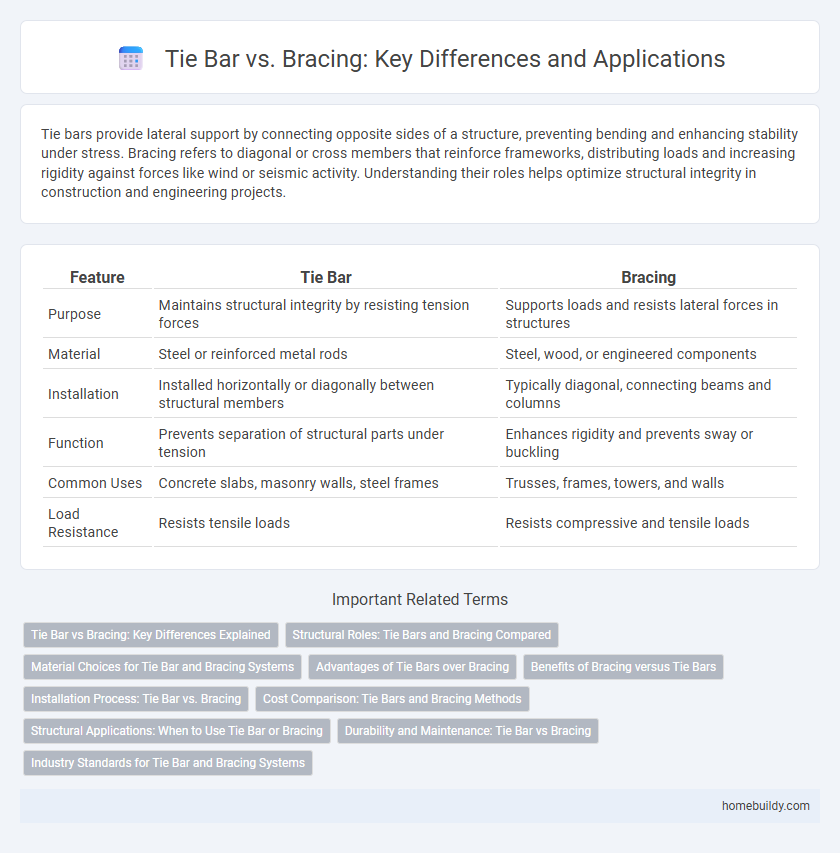Tie bars provide lateral support by connecting opposite sides of a structure, preventing bending and enhancing stability under stress. Bracing refers to diagonal or cross members that reinforce frameworks, distributing loads and increasing rigidity against forces like wind or seismic activity. Understanding their roles helps optimize structural integrity in construction and engineering projects.
Table of Comparison
| Feature | Tie Bar | Bracing |
|---|---|---|
| Purpose | Maintains structural integrity by resisting tension forces | Supports loads and resists lateral forces in structures |
| Material | Steel or reinforced metal rods | Steel, wood, or engineered components |
| Installation | Installed horizontally or diagonally between structural members | Typically diagonal, connecting beams and columns |
| Function | Prevents separation of structural parts under tension | Enhances rigidity and prevents sway or buckling |
| Common Uses | Concrete slabs, masonry walls, steel frames | Trusses, frames, towers, and walls |
| Load Resistance | Resists tensile loads | Resists compressive and tensile loads |
Tie Bar vs Bracing: Key Differences Explained
Tie bars and bracing both provide structural support but differ significantly in application and function. Tie bars primarily resist tension forces by linking components to prevent separation, while bracing stabilizes structures by resisting compression and lateral loads, often forming triangular configurations. Understanding these differences is crucial for selecting the appropriate reinforcement based on load type and architectural requirements.
Structural Roles: Tie Bars and Bracing Compared
Tie bars primarily provide tensile support by linking structural elements to resist lateral forces and prevent separation, enhancing stability in frameworks such as beams and slabs. Bracing systems, conversely, offer compressive and tensile resistance through diagonal members that stabilize structures against buckling and sway under load. Combining tie bars and bracing optimizes load distribution, ensuring comprehensive reinforcement in construction and civil engineering applications.
Material Choices for Tie Bar and Bracing Systems
Tie bars are commonly fabricated from high-strength steel, offering superior tensile capacity and durability compared to typical bracing materials such as aluminum or timber, which are often chosen for their lightweight and flexibility. Bracing systems utilize materials tailored to specific structural demands, including steel for rigid support or engineered wood products to balance load distribution and cost-effectiveness. Material selection for tie bars prioritizes mechanical performance and corrosion resistance, while bracing systems emphasize adaptability to dynamic loads and environmental conditions.
Advantages of Tie Bars over Bracing
Tie bars offer superior flexibility in load distribution compared to traditional bracing, providing enhanced structural stability under dynamic forces. Their streamlined design minimizes material usage and installation time, leading to cost-efficiency in construction projects. Unlike conventional bracing, tie bars allow for easier adjustments and integration within architectural frameworks, improving overall adaptability in various engineering applications.
Benefits of Bracing versus Tie Bars
Bracing provides superior structural stability by distributing loads more evenly across frames, reducing lateral movement and enhancing resistance to seismic forces compared to tie bars. Unlike tie bars, bracing systems offer increased stiffness and rigidity, which improves building durability and occupant safety during dynamic events. The use of bracing also allows for greater design flexibility and can accommodate larger spans without compromising structural integrity.
Installation Process: Tie Bar vs. Bracing
Tie bar installation requires precise alignment and secure fastening within concrete forms, ensuring load distribution across structural elements without extensive additional support. Bracing installation often involves adjustable frameworks or temporary support systems that need careful positioning to maintain stability during construction. The tie bar process is typically less time-consuming and integrates directly within the concrete, whereas bracing demands ongoing adjustments and more labor-intensive setup.
Cost Comparison: Tie Bars and Bracing Methods
Tie bars typically offer a lower initial cost compared to traditional bracing methods due to simpler installation and reduced material requirements. Bracing systems may incur higher expenses because of more extensive structural components and labor-intensive assembly processes. Choosing tie bars can lead to cost savings in both materials and labor while maintaining effective reinforcement for concrete structures.
Structural Applications: When to Use Tie Bar or Bracing
Tie bars provide tensile support by resisting elongation and are ideal for reinforcing structures under tensile stress, such as concrete slabs or masonry walls. Bracing offers compressive and lateral stability by preventing buckling and lateral movement, commonly used in steel frames and truss systems to enhance overall rigidity. Selecting between tie bars and bracing depends on the structural requirements: use tie bars for tension control and bracing for lateral load resistance and sway prevention.
Durability and Maintenance: Tie Bar vs Bracing
Tie bars provide superior durability compared to traditional bracing due to their solid steel construction and resistance to deformation under heavy loads. Maintenance requirements for tie bars are minimal as they do not rely on tensioned cables or hardware prone to corrosion, unlike bracing systems which often require regular inspection and tightening. This results in lower long-term costs and enhanced structural reliability for tie bar installations in construction and automotive applications.
Industry Standards for Tie Bar and Bracing Systems
Tie bars and bracing systems are engineered following strict industry standards such as ASTM A108 for high-strength steel used in tie bars and AISC standards for structural bracing components. Tie bars provide tensile support primarily in concrete structures to prevent cracking, while bracing systems stabilize frames against lateral forces, adhering to specifications outlined by the International Building Code (IBC). Compliance with these standards ensures the durability, safety, and performance of tie bars and bracing systems in seismic and wind load applications.
Tie bar vs Bracing Infographic

 homebuildy.com
homebuildy.com